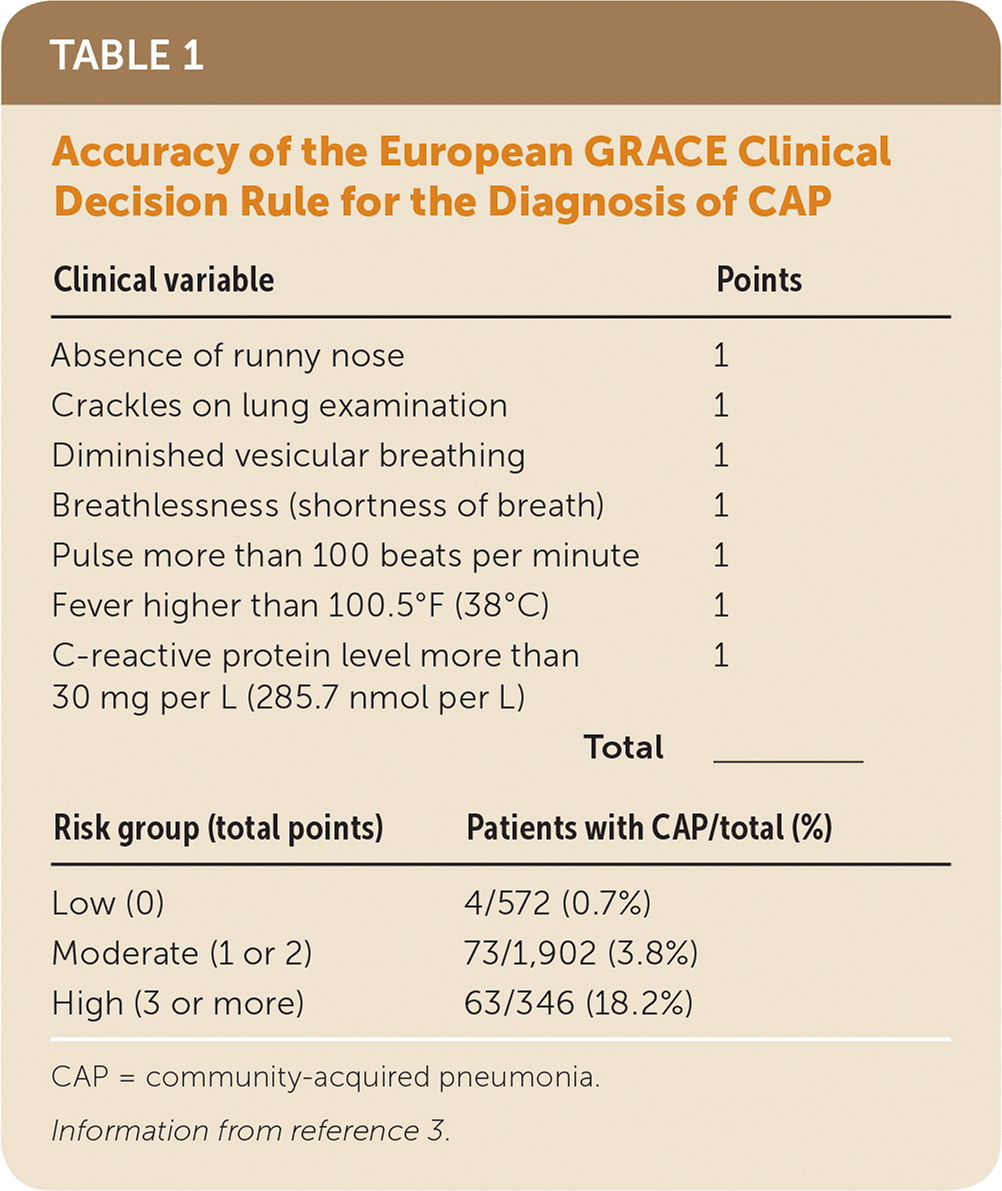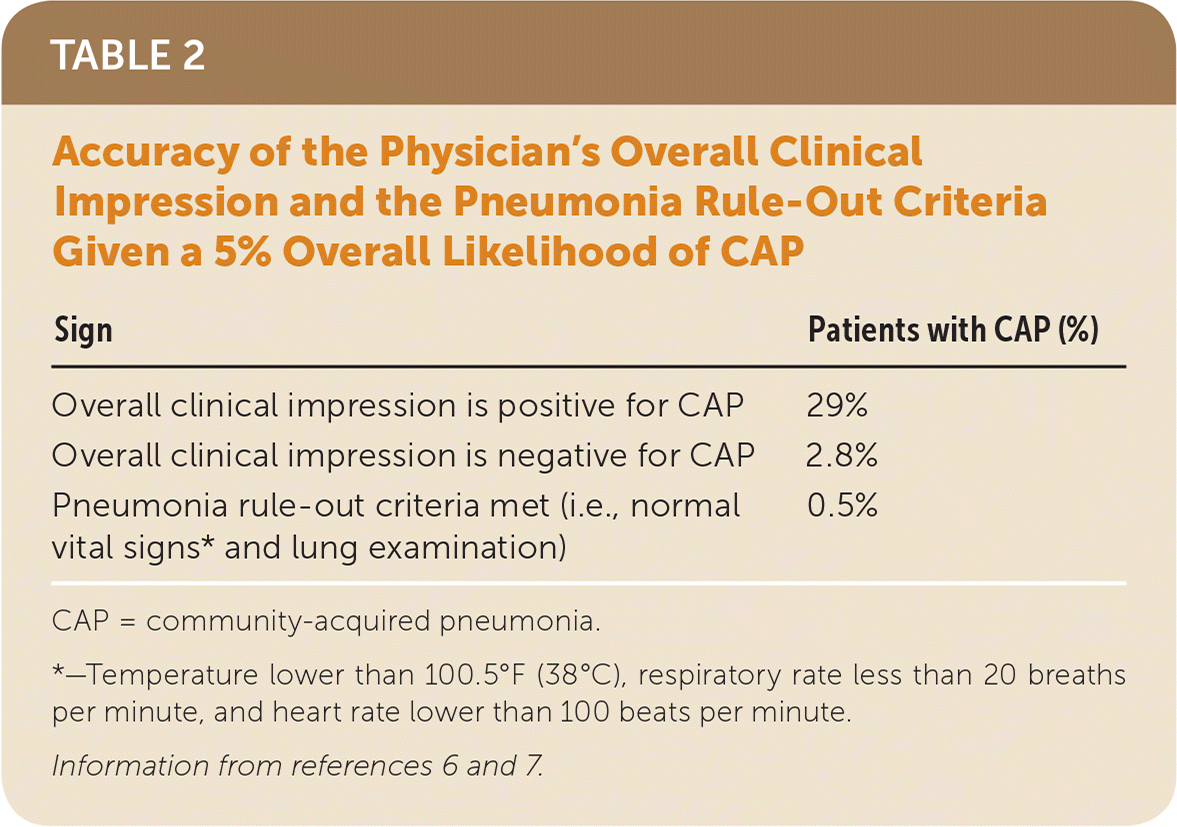
Am Fam Physician. 2019;100(4):246-247
Related letter: Positive Chest Radiograph Findings Are Not Enough to Warrant Antibiotics in Patients with Acute Cough
Author disclosure: No relevant financial affiliations.
Clinical Question
In patients with acute cough, is it possible to identify a subset with a very low likelihood of having community-acquired pneumonia (CAP)?
Evidence Summary
Acute cough is one of the most common reasons for patients to see a family physician and receive antibiotics.1 Although there is good evidence that most of these infections are viral and do not benefit from antibiotics,2 physicians may be concerned that they will miss a CAP diagnosis. It would therefore be helpful to identify a subset of patients with a very low risk of CAP, reducing not only the number of patients treated unnecessarily with antibiotics, but also the number who undergo chest radiography.
A large European study (GRACE) prospectively recorded signs and symptoms in 2,820 primary care patients with acute cough, all of whom received chest radiography. The study found that only 5% had CAP.3 Two older U.S. primary care studies also found a 3% to 5% prevalence of CAP among patients with acute cough.4,5
The signs and symptoms that best predicted pneumonia in the GRACE study were used to create a clinical decision rule that can be used to determine the likelihood of CAP (Table 13). The two older U.S. studies found a generally similar set of signs and symptoms to be predictive of CAP.4,5 Of note, the GRACE rule includes a C-reactive protein measurement, which is available as a point-of-care test in countries outside of the United States but requires a moderate-complexity laboratory in the United States. Another limitation of the GRACE rule is that most patients are classified in the intermediate-risk group, with only 20% falling into the low-risk group. Although helpful for identifying patients at high risk of CAP, all of these clinical prediction rules are less helpful for identifying patients at low risk.

| Clinical variable | Points |
| Absence of runny nose | 1 |
| Crackles on lung examination | 1 |
| Diminished vesicular breathing | 1 |
| Breathlessness (shortness of breath) | 1 |
| Pulse more than 100 beats per minute | 1 |
| Fever higher than 100.5°F (38°C) | 1 |
| C-reactive protein level more than | 1 |
| 30 mg per L (285.7 nmol per L) | |
| Total | _____ |
| Risk group (total points) | Patients with CAP/total (%) |
| Low (0) | 4/572 (0.7%) |
| Moderate (1 or 2) | 73/1,902 (3.8%) |
| High (3 or more) | 63/346 (18.2%) |
Physicians often do not use clinical decision rules to predict the risk of CAP and instead use their overall clinical impression, also called “clinical gestalt.” A recent systematic review identified 10 studies that reported the accuracy of clinical gestalt for the diagnosis of CAP (Table 26,7), with overall estimates of the positive and negative likelihood ratios of 7.70 and 0.54, respectively.6 Given a 5% baseline risk of CAP, those whose physicians have an overall clinical impression favoring pneumonia would have a 29% risk of CAP, and those whose physicians have a negative overall clinical impression would have a 2.8% risk of CAP.

| Sign | Patients with CAP (%) |
|---|---|
| Overall clinical impression is positive for CAP | 29% |
| Overall clinical impression is negative for CAP | 2.8% |
| Pneumonia rule-out criteria met (i.e., normal vital signs* and lung examination) | 0.5% |
Another recent study used clinical vignettes that systematically varied the likelihood of CAP and asked primary care physicians to make decisions regarding no testing or treatment, ordering a chest radiograph, or empirically starting antibiotics for patients with cough.8 Test and treatment thresholds were identified, with most physicians comfortable not ordering a chest radiograph when the probability of CAP was judged to be less than 10%. Thus, clinical gestalt is a useful tool for deciding which patients with cough should undergo chest radiography.
A number of studies have been designed to identify “rule-out criteria” that define a population of patients with cough who have a very low likelihood of CAP (Table 26,7). A systematic review identified three studies, with a total of 1,865 patients, that evaluated the accuracy of normal lung examination findings and normal vital signs (i.e., temperature lower than 100.5°F [38°C], respiratory rate less than 20 breaths per minute, and heart rate lower than 100 beats per minute) for ruling out pneumonia.7 The summary estimate of the negative likelihood ratio was 0.10 for patients meeting these criteria. Therefore, given a 5% overall likelihood of CAP, patients with normal vital signs and normal lung examination findings have only a 0.5% probability of CAP.
Bottom Line
Primary care patients with normal vital signs and normal lung examination findings have a very low risk of CAP (0.5%). A physician's overall clinical impression is also useful: when positive, there is an approximately 30% risk of CAP, and when negative only a 3% risk of CAP. If C-reactive protein testing is available, the GRACE rule can be applied, with an 18% risk of CAP in high-risk groups.
Applying the Evidence
A 62-year-old woman presents to your urgent care clinic with three days of worsening cough that was producing greenish sputum. She has coryza but normal vital signs and normal findings on lung examination, including no crackles. Her C-reactive protein level is 8 mg per L (76.2 nmol per L). Based on the GRACE rule, she receives 0 points. This is consistent with your overall clinical impression that CAP is unlikely. With normal vital signs and normal lung examination findings, you rule out pneumonia and recommend symptomatic treatment for an acute lower respiratory tract infection not related to pneumonia (often called acute bronchitis).
